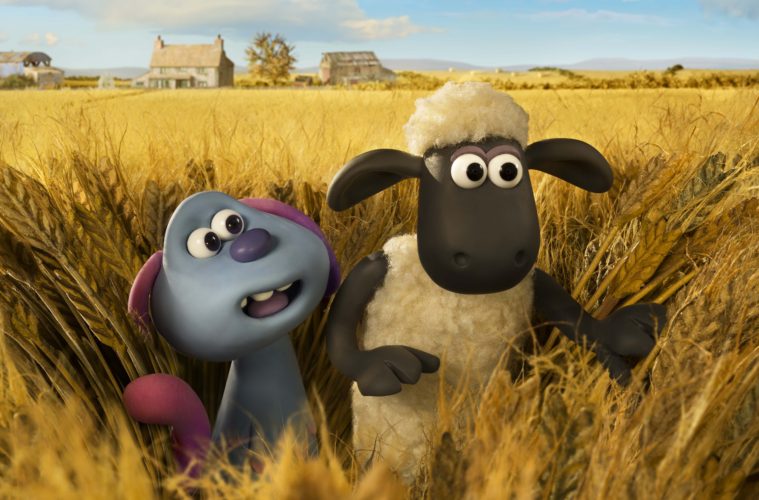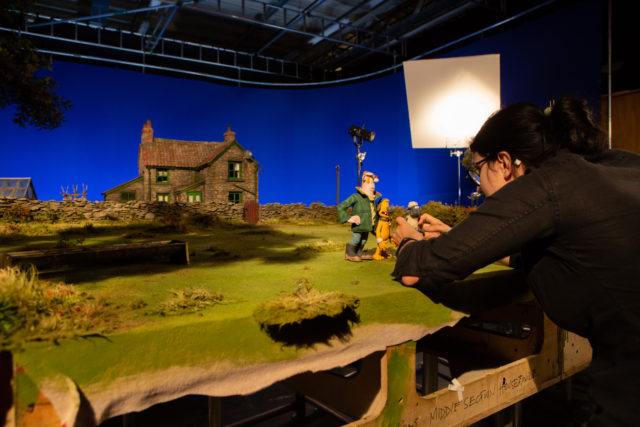Mark Simon-Hewis has recently been appointed as the Head of the Aardman Academy – a programme that ‘is committed to nurturing talent by delivering excellence in film and animation and mentoring’ (Aardman). In an interview with The Student Pocket Guide, Mark Simon-Hewis delves into his passion for animation, his journey as a filmmaker and animator, and his new role at the academy…
The Magical World of Animation: An Interview with Aardman’s Mark Simon-Hewis by Jessica Doran
Sat in his humble garden shed, Mark Simon-Hewis instantly broke the ice as he started speaking to me about the tribulations of remote working. We laugh about the reality that is now him walking to the bottom of his garden to have important meetings with Aardman clients.
After this down-to-earth introduction, I wanted to get stuck into discussing Mark’s new role at Aardman, and, for those that are unaware, what the Aardman Academy represents.
‘‘The whole purpose of the academy was to nurture talent, diversify the industry, and not be a closed-door so much. I think that’s what the industry does, it relies on the magic to a certain extent – the magic of going to the cinema and going ‘‘wow, how is that done?’’ That closed door is really difficult for people to open, and the academy was always a place to try and help that. So, I started working at the academy and doing the odd day of helping people learn and get into the industry. About 4 years ago we had this idea that we really needed to reach out to more people. That has always been our goal. We thought that maybe there is a way that we can send everybody around the world their own animation studio, and we help them set it up. We wrote it a long time ago and started to build it. We actually just graduated yesterday with our first cohort.’’
At this point, an approachable Mark apologises to me for being tired, admitting that he and the academy cohort spent the entire day yesterday having an online party. It sounds as though the academy enables you to build some great friendships, and Mark assures me that the online party ‘‘was pretty great,’’ before offering further depth into the responsibilities of his new role.
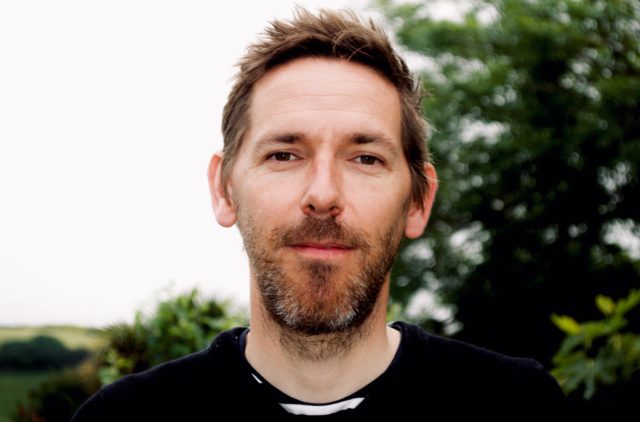
Mark Simon-Hewis
‘‘The academy has never really had anyone at the top making decisions; it has always been quite reactive to what the industry needs instead of proactive in terms of what we can give. So that’s my role now: to try and find ways to open up and share, and to make our industry more inclusive.’’
Mark’s role at Aardman has not always just been with the academy. Mark Simon-Hewis had already built a name for himself as a multi-award-winning British filmmaker prior to this role.
‘‘I’ve got quite a long journey at Aardman. It is a really brilliant place where it’s quite flexible and it really gives you space to move, and develop, and grow. I think there are a lot of people who started off as runners at Aardman who are now in key positions. I started 15 years ago or something and was just helping out on the studio floor, and I played Angry Kid. It’s a pixelated character with a head that is animated with a real body. My future wife was producing it and she and the director were saying they couldn’t get anyone to play Angry Kid because people kept fainting. I said ‘‘oh, I could do that.’’ From there I just kind of kept working on the studio floor and production managing, but all the time making films outside (they weren’t very Aardman-y; I didn’t even bother showing Aardman that I had made films). Then I made a film that did quite well (an animated film) and it was almost like ‘‘oh, you make films as well.’’ Then I started directing and making work for the BBC and Channel 4.’’
Having delved into Mark’s interesting past and career to date, I was eager to probe further into the Aardman Academy. It sounds like an excellent opportunity for keen animators, and so I asked Mark who the academy was targeted at and whether you had to have a specific skill set to apply.
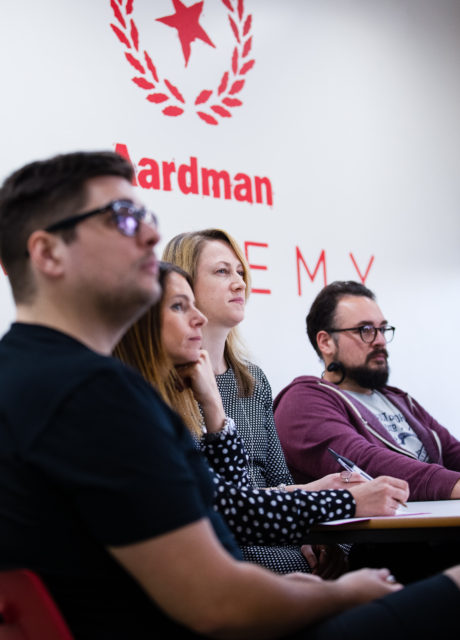
The Aardman Academy Classroom
‘‘In terms of the age group, it is really spread out. We can’t have people do the professional side of stuff who are under 18, but there are a good few people on the course who have never animated before and their work is amazing in just 12 weeks. There are also other people who come who are professionals; some people come and they want to treat it a bit like a writer’s retreat but with animation. So, they might be working on feature films or TV shows with a quick turnaround, and it’s a chance for them to come back and fall in love with the process and with what they’re doing. I don’t want to just give you the answer of ‘anybody is welcome,’ but we really do try to live up to that. We ask people to write 200 words and to send us work, but we make it really clear that those 200 words aren’t like a personal statement that you put to university. It’s not a test. It goes to your mentor and what you write on that 200 words forms part of the pack so that your mentor knows about you. The work is about knowing whether to accept or to reach out to you – this isn’t a ‘how to animate’ but more a ‘get good at animating’. It’s really diverse. It’s all around the world. We work with people to work out what’s best for them.’’
I was keen to know how much time it would take for someone who wanted to be part of the course but still had a degree to complete, or family commitments, or a job. Amazingly, Mark assures me that the course is not full-time.
‘‘The only way you can be truly inclusive is if you write things that allow people to do as much as they can and not punish people for not being able to do as much as other people. We’ve got a course called ‘Stop Motion 1’: they’re 12-week courses and it is about 10 hours a week minimum – but not maximum. Our working week is also Wednesday to Tuesday, so people have the weekend as well. Every week there is a hand-in of a task they are asked to do and that hand-in is Sunday. A lot of it is online and it’s free for anyone on the course to watch, so they can go back and watch at any time.’’
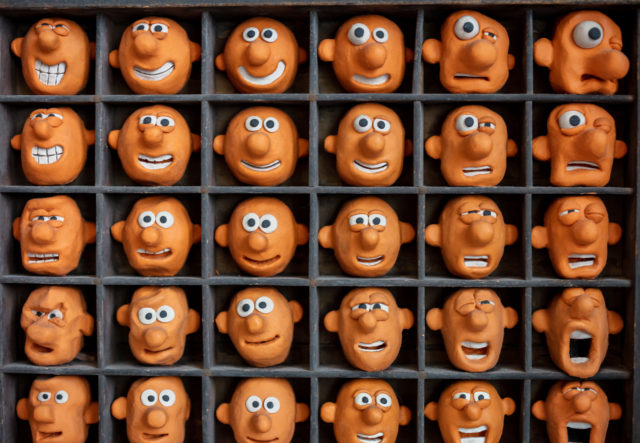
Aardman Work
With Mark speaking about the academy’s intentions to promote inclusivity and diversity, I wanted to touch upon other projects that Aardman had been involved with. A director at Aardman, Daniel Binns, had recently pitched a short film to the Scottish government to illustrate autistic people’s experiences of the world. With Aardman’s evident intentions to raise awareness, I wondered how the company was working to make children’s films more progressive.
‘‘We’re employee-owned now so we all own Aardman and run Aardman, so we all kind of decide what we think should be done. One of the things that grew out of that was the belief that we should have a diversity and inclusivity charter. Obviously, that covers everything from us employees, us as individuals, and our rights, but also the voices that we support in getting stories and storytelling onto the screen, and the characters that we represent on screen. It’s always hard for me to touch enough on what I can talk about in terms of Aardman projects coming up, but I think a big part of that diversity and inclusivity charter is making sure that all those key areas tie into that charter. Sarah Cox (who is looking after the green lighting of a lot of the new projects coming out at the moment) spoke the other day about how the characters at Aardman are a family, so everything we do has to feel like it’s part of the same family, but that doesn’t mean that the family can’t grow and become a family of diverse characters. With a lot of the projects coming up it expands on that family in a really wonderful way.’’
I thought that this analogy of the Aardman family felt very positive, and though Mark is sworn to secrecy regarding many of the upcoming Aardman projects, I am excited to see what is yet to come.
For certain, Aardman has continued to thrive in the animation industry, and only this year, Aardman’s A Shaun the Sheep Movie: Farmageddon was nominated for an Oscar for Best Animated Film. Looking at the fellow nominees, it dawned on me that each one had something in common. Out of all the nominations for Best Animated Film, two out of the five (Farmageddon and Over the Moon) involved some kind of exploration of space, while the other three (Wolfwalkers, Soul, and Onward) all explore connotations of magic. I had to ask whether there was a preference at the moment for otherworldly aspects in children’s films, and why this might be…
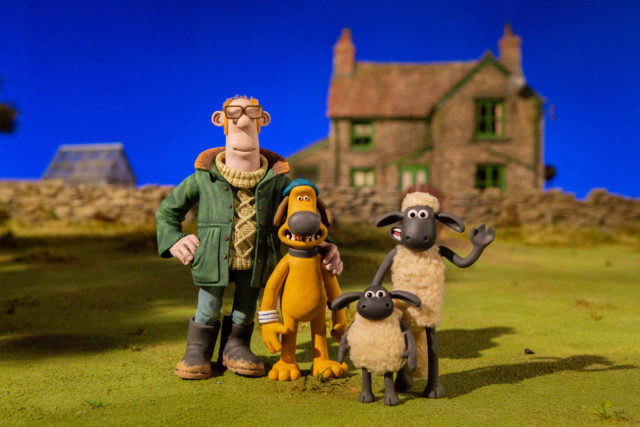
Shaun the Sheep
‘‘Obviously, animation takes so long. They were all projects that were finished by the time the world was hit by a pandemic. Marvel has probably had quite a big part to play in this and before that, it was Harry Potter and Lord of the Rings. I think it is that escapism and magic of other worlds that are always exciting for young viewers. Animation has always been about magic, even when it is stories about society, it’s always about something magical happening in that society because animation allows you to do it and it allows you to take characters into spaces. Yes, live-action can do that brilliantly nowadays with VFX, but animated films take you aesthetically into another dimension – rather than just narratively. Wolfwalkers, for example, it’s so stylised. It’s like you’re reading a beautiful picture book. It’s just one giant hug. They all create an aesthetic world that cocoons you and it is pure escapism and somewhere to experience joy. Maybe that’s the biggest influence of the last year. What we all needed was a big hug.’’
It seemed to me that Mark had suggested that the ‘magical’ element of animation is what enables it to compete in a world obsessed with CGI and visual effects. His references to Marvel, Harry Potter, and Lord of the Rings perhaps demonstrate certain inspirations for children’s film preferences, but I enjoyed Mark’s point about animation representing a completely different world – one that humans cannot be a part of. In this sense, animation will always be in its own league, and perhaps it does not have to compete with higher technology because it is not trying to merge with the human world; it is a separate imaginary place and always intends to be just that.
With this in mind, we began to speak about what upcoming animation films should be working to achieve.
‘‘I don’t think film creates society, it responds to it. I think animation is no different. I remember when I took my kids to watch Inside Out for the first time. I remember watching that and (firstly, crying and trying to hide it from my kids) but also that what we were seeing was Pixar responding to society and allowing children to try and understand what is going on inside their brains, and to give them a language to try and talk about emotion. I thought it was really underrated at how progressive it was. Then, all of a sudden you’re watching Moana and you’re going ‘‘yes, that’s the kind of woman I want my daughters to aspire to be!’’ I was incredibly happy when my daughters loved Moana. Animation film is holding up that mirror and trying to reflect whatever is happening right now in society. The entire animation industry is really open and upfront about diversifying the voices that are telling stories, and I know (particularly from Aardman’s point of view) that the desire to support those voices and get them on screen is a genuine commitment. However, the problem is that animation takes a long time, so right now it’s happening, but it’s going to take a while for those films to make it on to the screen.’’
Mark’s passion for animated film comes through entirely when talking to him. When I asked what was so appealing to him about animation, he replied: ‘‘it’s so magical!’’
Shortly after, Mark’s enthusiasm was highlighted as he began to show me the animation equipment he had lying around his shed.
‘‘Look what I’ve got here – this is their bones. It’s just wire. This is kind of how big Wallace is,’’ he says, beaming.
‘‘Animation is not about being clever, it’s about learning how to portray emotion in yourself in just things that are lumps of metal or plasticine. I think everyone has that one moment in animation where they see something, and it makes them go ‘‘wow!’’ It might be a barrel with a slit in the top where you do a ball and move it around, or a flipbook. The first time you see something and it comes to life, it is just magical.’’
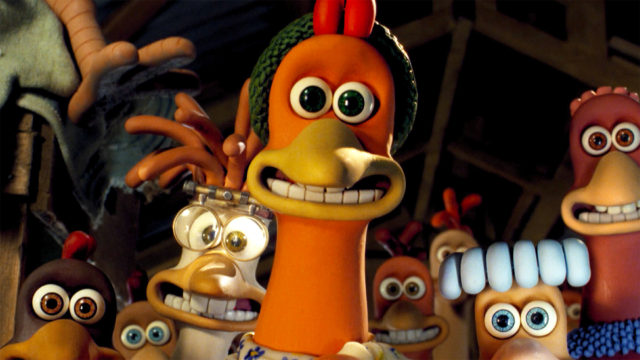
Chicken Run 2
As our interview came to a close, I hoped that Mark may have forgotten about my earlier attempts to probe into upcoming Aardman projects. I, therefore, tried my luck once more and asked if there was anything he could tell me about their forthcoming films.
Humorously, Mark responded: ‘‘if I told you I’d have to kill you, Jessica.’’
After quickly briefing the script he was given by the Aardman marketing team which informs Mark of what he is allowed to tell me, Mark then gave me a small premise of the latest Chicken Run film…
‘‘Having pulled off a death-defying escape at Tweedy’s farm, Ginger has finally found her dream at a peaceful island sanctuary for the whole flock far from the dangers of the human world where she and rocky hatch a little girl called Molly. Ginger’s happy ending seems complete, but back on the mainland, the whole of chicken kind faces a new and terrible threat. For Ginger and her team, even if it means putting their own one freedom at risk, this time they’re breaking in!’’
Well, we can look forward to Chicken Run 2, which will be streamed on Netflix globally in the near future.
Aardman certainly feels like a company that is intent on responding to society and the people around them. If you would like to be involved with Aardman and the world of animation, then you can read more about the work of Mark Simon-Hewis and the Aardman Academy here.
The Magical World of Animation: An Interview with Aardman’s Mark Simon-Hewis by Jessica Doran


